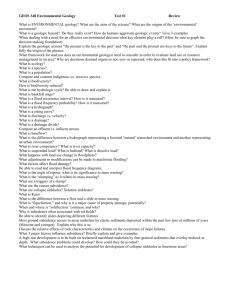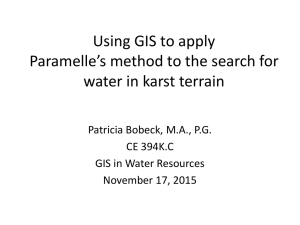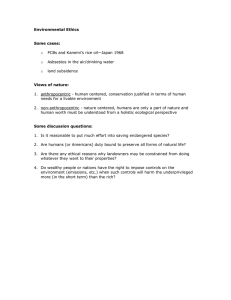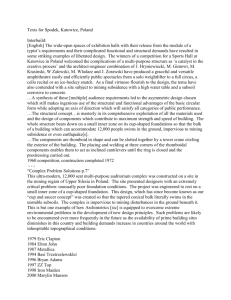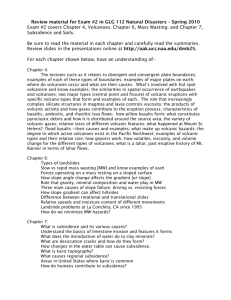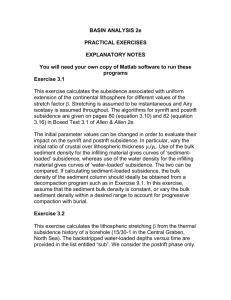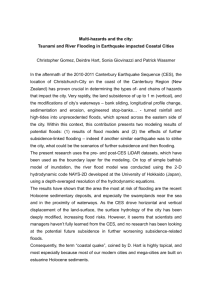A GIS-based prediction method of 3D ground sequence
advertisement
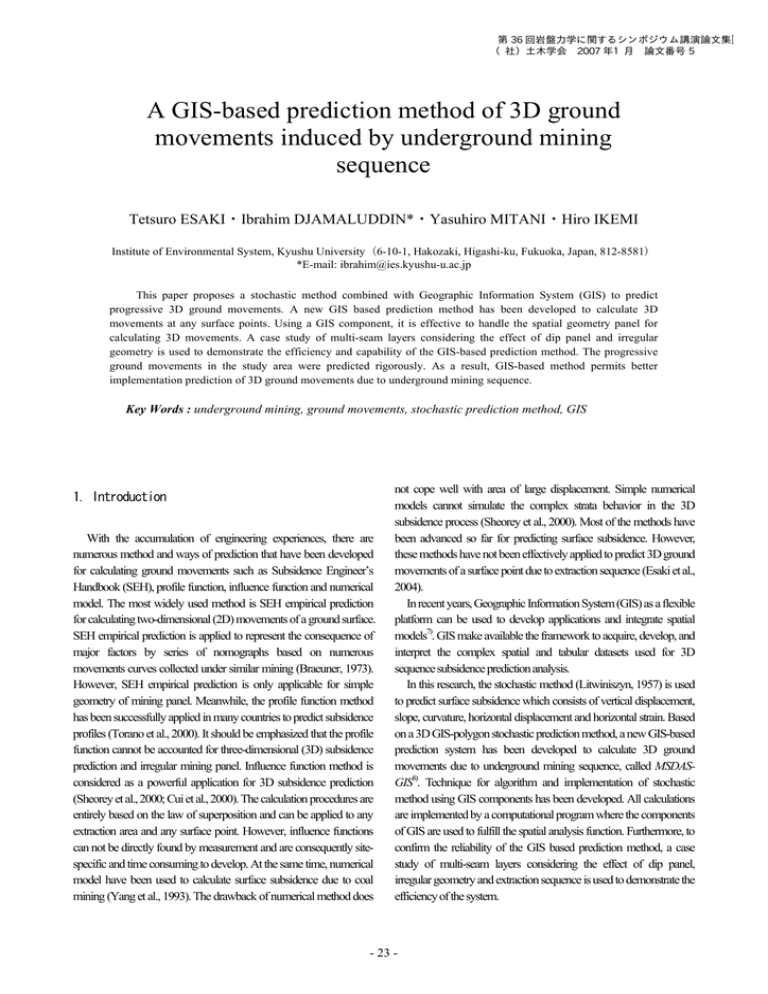
第 36 回岩盤力学に関するシンポジウム講演論文集
(社)土木学会 2007 年1月 論文番号 5
A GIS-based prediction method of 3D ground
movements induced by underground mining
sequence
Tetsuro ESAKI・Ibrahim DJAMALUDDIN*・Yasuhiro MITANI・Hiro IKEMI
Institute of Environmental System, Kyushu University(6-10-1, Hakozaki, Higashi-ku, Fukuoka, Japan, 812-8581)
*E-mail: ibrahim@ies.kyushu-u.ac.jp
This paper proposes a stochastic method combined with Geographic Information System (GIS) to predict
progressive 3D ground movements. A new GIS based prediction method has been developed to calculate 3D
movements at any surface points. Using a GIS component, it is effective to handle the spatial geometry panel for
calculating 3D movements. A case study of multi-seam layers considering the effect of dip panel and irregular
geometry is used to demonstrate the efficiency and capability of the GIS-based prediction method. The progressive
ground movements in the study area were predicted rigorously. As a result, GIS-based method permits better
implementation prediction of 3D ground movements due to underground mining sequence.
Key Words : underground mining, ground movements, stochastic prediction method, GIS
1. Introduction
With the accumulation of engineering experiences, there are
numerous method and ways of prediction that have been developed
for calculating ground movements such as Subsidence Engineer’s
Handbook (SEH), profile function, influence function and numerical
model. The most widely used method is SEH empirical prediction
for calculating two-dimensional (2D) movements of a ground surface.
SEH empirical prediction is applied to represent the consequence of
major factors by series of nomographs based on numerous
movements curves collected under similar mining (Braeuner, 1973).
However, SEH empirical prediction is only applicable for simple
geometry of mining panel. Meanwhile, the profile function method
has been successfully applied in many countries to predict subsidence
profiles (Torano et al., 2000). It should be emphasized that the profile
function cannot be accounted for three-dimensional (3D) subsidence
prediction and irregular mining panel. Influence function method is
considered as a powerful application for 3D subsidence prediction
(Sheorey et al., 2000; Cui et al., 2000). The calculation procedures are
entirely based on the law of superposition and can be applied to any
extraction area and any surface point. However, influence functions
can not be directly found by measurement and are consequently sitespecific and time consuming to develop. At the same time, numerical
model have been used to calculate surface subsidence due to coal
mining (Yang et al., 1993). The drawback of numerical method does
not cope well with area of large displacement. Simple numerical
models cannot simulate the complex strata behavior in the 3D
subsidence process (Sheorey et al., 2000). Most of the methods have
been advanced so far for predicting surface subsidence. However,
these methods have not been effectively applied to predict 3D ground
movements of a surface point due to extraction sequence (Esaki et al.,
2004).
In recent years, Geographic Information System (GIS) as a flexible
platform can be used to develop applications and integrate spatial
models7). GIS make available the framework to acquire, develop, and
interpret the complex spatial and tabular datasets used for 3D
sequence subsidence prediction analysis.
In this research, the stochastic method (Litwiniszyn, 1957) is used
to predict surface subsidence which consists of vertical displacement,
slope, curvature, horizontal displacement and horizontal strain. Based
on a 3D GIS-polygon stochastic prediction method, a new GIS-based
prediction system has been developed to calculate 3D ground
movements due to underground mining sequence, called MSDASGIS8). Technique for algorithm and implementation of stochastic
method using GIS components has been developed. All calculations
are implemented by a computational program where the components
of GIS are used to fulfill the spatial analysis function. Furthermore, to
confirm the reliability of the GIS based prediction method, a case
study of multi-seam layers considering the effect of dip panel,
irregular geometry and extraction sequence is used to demonstrate the
efficiency of the system.
- 23 -
GIS-grid points
2. GIS-based prediction method of 3D movements
P
Surface
P(i, j)
P (dA) = C ( x 2 )dx.C ( y 2 )dy = C ( x 2 )C ( y 2 )dA
(1.a)
y’
z
y
dy
Surface
x
ϕ
O
x’
P(dA)
y
dx
x
C (x2 )
2
C( y )
H
H4
P4 ( x4 , y 4 ) (∂S / ∂m) dz
∂l
∂m
H1
Se
y
∂w
H3
(∂v x / ∂w) dx
x
Extraction element
P1 ( x1 , y1 )
P3 ( x3 , y3 )
Extraction panel
(∂v y / ∂l ) dy
H2
P2 ( x2 , y 2 )
Fig.1 A sketch to illustrate the effects of the extraction
element upon the arbitrary point P at the surface.
Sp
H4
y
rik
ed
i re
cti
on
dSp
St
(1) Stochastic influence function coefficient
It is complicated to model ground movements due to mining since
the overburden strata behaves in a complex manner. Several kinds of
idealized medium have been used in subsidence prediction9). The
degree of freedom of a single block is too large for classical
mechanics to be able to define the motion trajectories of rock particles
precisely. According to J. Litwiniszyn (1957), since a rock mass can
be considered as a stochastic medium, its motion problem can be
solved by stochastic method.
In Fig.1, according to stochastic method of ground movements,
an underground extraction panel can be divided into infinitesimal
extraction areas. The consequence due to the original extraction
would be equal to the sum of the effects caused by those infinitesimal
extractions. An extraction with an infinitesimal unit of width, length
and thickness ( ∂w∂l∂m ) is called the extraction elements10). The
vertical displacement of any point in the subsidence trough is called
the basic influence function of vertical displacement Se.
A rectangular coordinate system is chosen with vertical axis z
directed upward from the extraction element. Based on the stochastic
method, the occurrence of a rockmass motion over the extraction
element may be a random event which takes place with a certain
probability. The occurrence of the event that surface movement in an
infinitesimal area dA = dx.dy at the horizon z with point P(x,y,z) at its
center is equivalent to the simultaneous occurrence of two events
composed of a movement in the horizontal strip dx and the horizontal
strip dy through P.
The probability for a simultaneous occurrence of these two events
is
C
P4 ( x4 , y 4 )
H3
β1
H1
GIS-3D polygon
A
α
P1 ( x1 , y1 )
Extraction panel
D
P3 ( x3 , y3 )
x
β2
H2
Dip d
ir
ectio
n
P2 ( x2 , y2 )B
Fig.2 Illustration of GIS-based 3D-polygon as a panel to
calculate subsidence at GIS point as surface points.
Finally, the calculation point P(x, y) is located at the origin of the local
coordinates, then the subsidence of a surface point P can be derived as
follows:
S ( x, y ) = m.a.z. cos α ⋅ C y ⋅ C x ,
(1.b)
Cy =
y
y−l
1
( Erfc ( π ⋅ ) − Erfc ( π ⋅
)),
r
r
2
(1.c)
Cx =
x
1
x−w
( Erfc( π ⋅ ) − Erfc( π ⋅
)).
r1
2
r2
(1.d)
where a = subsidence factor; m = extraction thickness; α = angle
of dip; l = panel length along strike; w = panel width along dip;
r = H / tan β , r1 = H1 / tan β1 , r2 = H 2 / tan β 2 , radius of
the influence circle; β = angle of draw; and H = depth along strike,
H1 = depth along the boundary of rise side, H 2 = depth along the
boundary of dip side; z = subsidence time factor.
(2) Stochastic prediction using GIS based components
The stochastic influence coefficient can also be applied for 3D
GIS-polygon as geometry model for subsidence prediction of surface
points. By the integration of all small extraction elements into a
extraction panel as shown in Fig.1, all the subsidence components
related surface calculation point can be illustrated by the 3D view of
GIS-grid points (calculation points) and 3D polygon (extraction
panel) as shown in Fig.2. The extraction area can be divided into
panels and related to polygon-based areas. For each panel, with
reference to the vector-based polygon (Fig.3), the spatial data of
geometry, panel sequence, subsidence parameters, and extraction
depth can be obtained from the 3D polygon. In this polygon panel
dataset, a feature table of 3D polygon is used to relate the subsidence
parameters. In 3D polygon attribute table, the item of “PolygonZM”
is the shape of 3D polygon attributes and the item of “ID” is the
extraction sequence; the items of “AngDip.(Dip inclination)”,
“UpwardAng.(panel upward angle)” and “Thick.(Extraction
thickness)” are related to the geometrical parameters.
- 24 -
Vertices panel FID 1
0
1
2
3
x
y
39483108.188
39482988.188
39482988.188
39483108.188
3920887.694
3920887.694
3921067.694
3921067.694
Start
z
-561.000
-543.000
-513.000
-526.000
Input 3D polygon with
subsidence parameters
t
Eas
Read parameters: panel ID; dip
inclination; upward angle;
extraction thickness; subsidence
factor, horizontal movement
factor; time factor; draw angles
3
2
γ
Upward angle
FID 0
Wes
t
FID 3
FID 2
FID 1
1
0
Shape
PolygonZM
PolygonZM
PolygonZM
PolygonZM
Working panel number
ID
1
2
3
4
Loop for each depth
vertex in a panel
x, y coordinate of panel
vertex transform
Loop for working panel
3D view of extraction panel
Array of x, y coordinate of
panel vertex transform
Confirm x, y coordinate for
validation
3D polygon panel attributes dataset
FID
0
1
2
3
x, y coordinates of depth
panel vertex
AngDip Thick SubFac HoMoFac TiFac UpTan DownTan UpwardAng
9.481 6.29
0.70
0.30 0.50 1.428
1.428
123.45
125.34
12.907 6.29
1.428
0.70
0.30 0.50 1.428
10.796 6.29
0.70
0.50
1.428
126.24
0.30
1.428
2.130 6.29
1.428
146.31
0.70
0.30 0.50 1.428
Read parameters: point number
along grid line; grid line number;
point interval; line interval in x
and y; x, y coordinates start point
of grid line
Loop point on the grid
line and grid line
Array of x, y points
coordinates
Generate surface
grid points
Calculate subsidence components
based on assign working panel
Array result of subsidence
components
Fig.3 An example of 3D GIS-polygon panels and its related
Write/plot the result: vertical disp.; tilt;
curvature; horisontal. disp; strain
spatial data geometry with attribute dataset.
i = 1, 2, 3...n
The subsidence parameters are represented by the items of
“SubFac.(Subsidence factor)”, ”HoMoFac.(Horizontal movement
factor)”, “TiFac.( Time-delay subsidence factor)”, “UpTan. (Tangent
of draw angle in rise side)”, and “DownTan.( Tangent of draw angle
in dip side)”. Each 3D panel has depth vertices value that giving a
spatial geometry in x, y, and z. Therefore, a 3D panel has spatial
geometry which can be used to identify the main strike direction and
dip inclination of each panel. In addition, a spatial model and TIN
(triangulated irregular network) model in GIS are employed to
analyze a 3D panel for identifying strike direction and dip inclination.
(3) Algorithm implementation of GIS stochastic
prediction analysis
The whole underground mining area can be divided into many
panels that are the same as the GIS-based 3D-polygon panel layer.
The prediction system has been developed in the most popular of GIS
software. GIS software is based on a common modular COM-based
library of shared GIS components called ArcObjects. For subsidence
prediction system, the stochastic calculation procedures are
programmed by Visual Basic (VB) 6.0 using ArcObjects. In this
program, the VB 6.0 and ArcObjects are employed, ArcObjects as a
GIS component is used to implement GIS data processing and
spatial-temporal analysis.
All input data for subsidence prediction are available using the
function of GIS. The input parameters for subsidence calculations are
divided into two categories. The first parameter is to generate surface
grid points for providing calculation points, including the distance of
each grid point in x and y directions. The second parameter is to input
subsidence calculation data including extraction sequence number
(panel ID), dip inclination, upward angle, extraction thickness,
subsidence factor, horizontal movement factor, time factor and angles
of draw. Fig.4 illustrates the flow chart for computational process. In
computational subsidence process, the panel on the global coordinate
system is transformed into the local coordinate system. The
transformation coordinate panel is performed to obtain the angle
direction of zone radius of main subsidence influences.
Next
panel
End
Fig.4 Flow chart for algorithm of subsidence prediction.
The confirmation of x, y coordinate transform panel is taken to
ensure a validation of geometry model before stochastic calculation
process. By inputting calculation points, subsidence parameters and
3D polygon panel, 3D ground movements are calculated in the
stochastic function procedures according to working panel (extraction
sequence). After the entire calculations are finished, the movement
components which consists of vertical displacement as well as slope,
curvature, horizontal displacement and horizontal strain can be
created to GIS-grid points as a database. Without GIS, a 3D
subsidence calculation based on stochastic influence function would
be a difficult and time-consuming, and multi panel-case study
analysis would also be problematic. However within GIS system,
subsidence calculation related data of the whole study area can be
represented as GIS vector layers. For each vector layer, a 3D polygon
and grid point-based layer can be constructed using GIS and the
calculation grid points can be set with the requisite precision.
(4) Computational processes using GIS spatial analysis
function
The subsidence calculations can be carried out within or outside
the GIS. If the calculations are performed outside the GIS, the GIS
system is only used as a spatial subsidence database for storing,
displaying and updating the input data. The main advantage of this
approach is that external existing subsidence prediction models can be
used without losing time in programming the model algorithms into
the GIS. However, prediction models calculate the movements of a
surface point for an extraction panel in three dimensions. Since an
area consists of many panel and complex geometry, the use of this
3D model of subsidence is very time-consuming, as each panel has to
be analyzed separately. In order to overcome the problem of complex
geometry data conversion, model of subsidence calculations should
be performed within the GIS.
- 25 -
GIS layers (surface elevation, seam
elevation, mining excavation map)
GIS-polygon panels. For stochastic subsidence analysis, all of the
above calculation procedures are programmed by VB 6.0 using GIS,
assigns 3D-polygon panels as a mining geometry model to the
boundary extraction panel vertices and writes the subsidence
components result to GIS grid-points.
Data module
Polygon panel
layer
Point depth layer
GIS spatial
analysis
Parameters
( a , b , β1, β )2
Parameters ( α, γ)
Data module
Step= 1,2,...n
Parameters
(surface points)
3. Application of GIS-based prediction method
3D-polygon panel layer
(1) Background of study area (Fig.6)
Seita water reservoir as a part of study area is located in
KitaKyushu, Japan. There are four dams along the reservoir with the
height and length of 23.5/217.6 m, 18.0/49.4 m, 21.0/186.2 m and
17.0/76.3 m, respectively. Underground coal mining was started from
1944 and finished in 1965. The direction of coal seam along the strike
is N20o~30oSW and dip direction is 15o-20oNE according to the
geological condition in mining practices and borehole data at several
measurement points in the previous study. There are four levels of
coal seam layers with extraction ranged depth from 200 m to 1200 m
below surface, thickness of first, second, third, and fourth coal seam
layers are 1.20 m, 0.83 m, 1.43 m, and 1.80 m, respectively. The coal
mining is extracted by the longwall method. Fig.6 shows the 4 level
seam layers of all extracted panel area over 22-year mining period.
Stochastic
prediction
module
3D prediction of surface subsidence
Vertical disp; slope; curvature; horizontal
disp.; horizontal strain
GIS spatial
analysis
Subsidence gridpoints
Subsidence kriging
interpolation
Annotations
Data module
Related
Progress
Function
Result output and
simulation
Data
Fig.5 Entire subsidence computational processes using GIS
spatial analysis.
In Fig.5, it can be seen that all modules are related to the GIS
spatial analysis function that implemented by a GIS component. In
this process, the function of data module is used for getting all the
subsidence related spatial geometry, surface point calculation data and
the subsidence parameters. The stochastic prediction module is used
for calculating surface subsidence as well as slope, curvature,
horizontal displacement and strain.
(5) Implementation steps for predicting subsidence in
GIS
There are three-step processes in order to implement a 3D ground
movement prediction in GIS environment. In Step 1, It involves
establishing the spatial extents of the study area, deciding an
appropriate working projection, and assembling the various spatial
data to be used in the study in digital form to be properly registered
that the spatial component overlap correctly. This step is to bring all
the appropriate source data together into a GIS spatial database such
as mining panel map, seam layer, surface elevation layer and spatial
information of overburden strata. In Step 2, it involves constructing
the spatial geometry of mining panel for subsidence calculation
parameters. In common case, the mining panel map must be digitized
manually, transformed from image into a 3D GIS-polygon vector
data. Since, it is necessary to input the elevation value of 3D polygon
panel into the subsidence computation model, each panel is required
for panel vertices depth (coordinate in z direction). In Step 3, it
involves applying the subsidence prediction, combining all the
prepared data that provided the value of subsidence calculation. All
parameters of subsidence must be inputted and corresponded to 3D
(2) Calculation of 3D ground movements and simulation
Sequential subsidence calculations simulating the extraction
process between 1944 and 1967 were carried out employing
parameters of subsidence factor (a) = 0.85, horizontal movement
factor (b) = 0.21, tangent of draw angle = 1.428 obtained from
previously experienced results. Effect of time factor which expresses
the time-delay subsidence shows the final value completed in 3 years
( first year (z1) = 0.83, second year (z2) = 0.90, third year (z3) = 1)
after complete mining even at depth, and the maximum subsidence
records 3.27 m up to 1967.
- 26 -
3.8 km
Orio JR station
Roads
Dams
Seita reservoir
JR lines
Buildings
Coal seam layer 1
North
Coal seam layer 4
1.2 km
Coal seam layer 2
Coal seam layer 3
Fig.6 3D view of underground coal mining panels under Seita
reservoir area.
{
{
Subsidence,
mmm
Subsidence,
-3,266
- -3,015
-3,266
- -3,015
-3,015
- -2,764
-3,015
- -2,764
Years
44 45 46 47 48 49 50 51 52 53 54 55 56 57 58 59 60 61 62 63 64 65 66 67
50
0 0
250250
500500 1,000
Meters
1,000
Meters
0
Subsidence (mm)
-2,764
- -2,512
-2,764
- -2,512
-2,512
- -2,261
-2,512
- -2,261
-2,261
- -2,010
-2,261
- -2,010
-2,010
- -1,759
-2,010
- -1,759
-1,759
- -1,507
-1,759
- -1,507
-1,507
- -1,256
-1,507
- -1,256
2
-1,256
- -1,005
-1,256
- -1,005
-1,005
- -754
-1,005
- -754
-754-754
- -502
- -502
7
-502-502
- -251
- -251
-251-251
- -0- -0
-50
-100
-150
-200
-250
-350
1
Calculated Value
-300
Measured Value
-400
-450
6
Point no.2
0
Years
Legend
Legend
Measured points
44 45 46 47 48 49 50 51 52 53 54 55 56 57 58 59 60 61 62 63 64 65 66 67
50
0
Subsidence (mm)
Limit
subsidence
Limit
subsidence
Reservoir
dams
Reservoir
dams
Water
Water
Coal
extraction
panel
Coal
extraction
panel
Fig.7a 3D subsidence prediction due to coal mining up to 1955.
-50
-100
-150
-200
-250
-300
-350
-400
-3,266
- -3,015
-3,266
- -3,015
-3,015
- -2,764
-3,015
- -2,764
-500
-550
Fig.8 Comparison of measured and predicted subsidence values .
-2,261
- -2,010
-2,261
- -2,010
-2,010
- -1,759
-2,010
- -1,759
0
-1,759
- -1,507
-1,759
- -1,507
-1,507
- -1,256
-1,507
- -1,256
-502-502
- -251
- -251
-251-251
- -0- -0
In addition, the calculation time consumed using this developed
system indicated approximately 100 times faster than that of the
previous method which was developed by Esaki (1996)11). The detail
of ground movements due to coal mining, which can be sequentially
predicted and simulated in term of year, is shown in Fig.7 as an
example. Final subsidence distribution simulation due to 22-year
extraction is shown in Fig. 7c.
2
7
1
6
Legend
Legend
Measured points
Years
Limit
subsidence
Limit
subsidence
44 45 46 47 48 49 50 51 52 53 54 55 56 57 58 59 60 61 62 63 64 65 66 67
Horizontal strain (mm/m)
Reservoir
dams
Reservoir
dams
Water
Water
Coal
extraction
panel
Coal
extraction
panel
Fig.7b 3D subsidence prediction due to coal mining up to 1961.
Subsidence,
mm m
Subsidence,
0
{
{
0 250
500500 1,000
Meters
0 250
1,000
Meters
0.55
0.5
0.45
0.4
0.35
0.3
0.25
0.2
0.15
0.1
0.05
0
-0.05
-0.1
Calculated Value
Measured Value
Restriction value of concrete dam
Point no.1
Years
2
44 45 46 47 48 49 50 51 52 53 54 55 56 57 58 59 60 61 62 63 64 65 66 67
7
Horizontal strain (mm/m)
-3,266 - -3,015
-3,266 - -3,015
-3,015 - -2,764
-3,015 - -2,764
-2,764 - -2,512
-2,764 - -2,512
-2,512 - -2,261
-2,512 - -2,261
-2,261 - -2,010
-2,261 - -2,010
-2,010 - -1,759
-2,010 - -1,759
-1,759 - -1,507
-1,759 - -1,507
-1,507 - -1,256
-1,507 - -1,256
-1,256 - -1,005
-1,256 - -1,005
-1,005 - -754
-1,005 - -754
-754 - -502
-754 - -502
-502 - -251
-502 - -251
-251 - -0
-251 - -0
Point no.7
0 0
250250
500500 1,000
Meters
1,000
Meters
-2,764
- -2,512
-2,764
- -2,512
-2,512
- -2,261
-2,512
- -2,261
-1,256
- -1,005
-1,256
- -1,005
-1,005
- -754
-1,005
- -754
-754-754
- -502
- -502
Measured Value
-450
{
{
Subsidence,
mmm
Subsidence,
Calculated Value
1
6
Legend
Legend
Measured points
Limit
subsidence
Limit
subsidence
Reservoir
dams
Reservoir
dams
0.55
0.5
0.45
0.4
0.35
0.3
0.25
0.2
0.15
0.1
0.05
0
-0.05
-0.1
Restriction value of reservoir bottom
Calculated Value
Measured Value
Point no.6
Water
Water
Coal
extraction
panel
Coal
extraction
panel
Fig.9 Comparison of measured and predicted horizontal strain
Fig.7c 3D subsidence prediction due to coal mining up to 1967.
- 27 -
values.
Several measurement points studied to obtain movement data year
by year. The comparison of calculated and measured subsidence
values is shown in Fig.8. The calculation of horizontal strains can
also be obtained over time. As shown in Fig.7, the measured points
for horizontal strains along the survey line on the concrete dams and
reservoir bottom obtained over years. The comparison of measured
and predicted horizontal strain values that shows the dynamic strain at
the reservoir dams and strain recovery response to mining extraction
sequence is shown in Fig.9. The calculated strains were conformed
to the allowable strain of dams to ensure the safety against tensile
failure of concrete and water inundation.
4. Conclusion
A GIS-based prediction method has been developed for
calculating 3D ground movements at any surface point with any
shape of extraction covering a wide range of mining geometry.
Unlike most research that has taken the 2D prediction method to
calculate final subsidence process, in this study, the stochastic method
integrated with GIS component is used for the 3D ground
movements due to underground mining sequence. A computational
program called MSDAS-GIS, in which GIS component is used to
fulfill the GIS spatial analysis function and effective data
management, has been developed to implement all calculation of the
3D ground movements. Using a 3D GIS-polygon and GIS-grid
points for subsidence prediction analysis, an efficiency calculation
process is developed for predicting 3D ground movements. The
ground movements due to 22-year underground coal extraction in the
study area were simulated and predicted rigorously and the best
efficiency. Within GIS, the data preparation and visualization for
progressing subsidence distribution, the phenomena of 3D ground
movements sequence is ideal to study. The comparison between
calculation and measurement values show good concurrences.
Reference
1) Braeuner, G. : Subsidence due to underground mining. Theory and
practices in predicting surface deformation, US.IC 8571,1973.
2) Torano, J., Rodriguez, R., Ramirez-Oyanguren, P. : Probabilistic analysis of
subsidence-induced strains at the surface above steep seam mining. Int. J.
Rock Mech. Min. Sci. 37, pp. 1161-1167, 2000.
3) Sheorey, P.R., Loui, J.P., Singh, K.B., Singh, S.K. : Ground subsidence
observations and a modified influence function method for complete
subsidence prediction. Int. J. Rock Mech. Min. Sci. 37, pp. 801-818, 2000.
4) Cui, X., Miao, X., Wang, J., Yang, S., Liu, H., Song, Y., Liu, H., Hu, X.:
Improved prediction of differential subsidence caused by underground
mining. Int. J. Rock Mech. Min. Sci. 37, pp. 615-627,2000.
5) Yang, G., Chugh, Y.P., Yu, Z., Salamon, M.D.G. : A numerical approach
to subsidence prediction and stress analysis in coal mining using a
laminated model. Int. J. Rock Mech. & Min. Sci. & Geomech. Abstr. 30, pp.
1419-1422,1993.
6) Esaki, T., Djamaluddin, I., Mitani, Y., Zhou, G. : Synthesis subsidence
prediction method due to underground mining integrated with GIS.
Proceeding 3rd ISRM Kyoto Int. Symp ARMS. Kyoto, pp.147-152,2004.
7) Longley, P.A., Goodchild, M.F., Maguire, D.J., Rhind, D.W. : Geographic
Information Systems and Science, p. 377,John Willey & Sons,2001.
8) Esaki, T., Djamaluddin, I., Mitani, Y. : Development of GIS-based spatial
and dynamic subsidence prediction system above complex underground
mining. Proceeding 31st Int. Conf. Safety in Mines Research Institute.
Brisbane-Australia, pp.224-227,2005.
9) Gil, H. : The Theory of Strata Mechanics, p.7, Elsevier,1991.
10) Litwiniszyn, J. : The theories and model research of movements of ground
masses. Proceeding European Congress on Ground Movement. LeedsEngland, pp.202-209,1957.
11) Esaki, T., Shikata, K., Jiang, Y. : The proposal of a new influence function
method to predict subsidence and some applications. Proceeding 2nd SinoJapan Strata Environment Mechanics. China, pp.177-182,1996.
GIS を用いた地下採掘による三次元地表移動の予測法
江崎 哲郎, Ibrahim DJAMALUDDIN, 三谷 泰浩, 池見 洋明
地下採掘による地表移動について,これまで多くの予測計算法が用いられてきた.しかし,従
来の予測計算法は,採掘の進行に伴う地表の限られた地点の挙動しか得ることができなかった.
本研究では,GISを用いた影響係数沈下予測法を提案したものである.この方法では,進行し
つづける採掘にともなう地表の地盤移動を連続的に三次元的に求めることができる.特に複雑
な形状をした採掘パネル毎にポリゴン化する方式は精度向上に寄与する.この方法の有効性お
よび格段の効率性は累層採掘の実例により検証された.
- 28 -
